PinotFile: 12.31 August 19, 2022
|
Tyee Wine Cellars Consistently Produces Outstanding Oregon Pinot NoirYou probably have not heard of this small, rural, modestly-publicized winery, but I urge you to get acquainted. Located in the outskirts of Corvallis on the scenic Buchanan Family Century Farm founded over 130 years ago, The estate’s 450 acres have been owned by the Buchanan family since 1854. Today, the fourth generation Buchanans, Dave and Margy Buchanan own the farm, the Tyee Estate Vineyard and Tyee Wine Cellars Winery. In 1985, the Buchanans partnered with Oregon State University enologist Barney Watson and his spouse, Nola Mosier, to start the Tyee Winery. In 2005, the Buchanans became the sole owners of Tyee Wine Cellars. Tye Wine Cellars is still used as a teaching winery for Oregon State University. The name, Tyee, honors the Kalapooian Indians who encamped on the Corvallis property. Tyee translates to ‘chief’ or ‘the best of’ in Northwest Indian trade dialect. The winery’s bottle labels honor the Indian heritage.
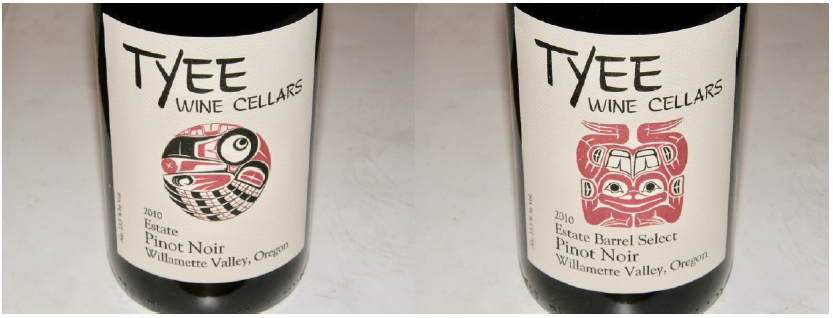 Wine grapes, including own-rooted Pinot Noir, Pinot Gris, Chardonnay, and Gewürztraminer were first planted here in 1974, making the Buchanans one of the early wave of enthusiastic Oregon Pinot Noir pioneers. Currently, the Tyee Estate Vineyard has 3 acres of own-rooted Pommard clone Pinot Noir planted over the years 1974, 1981, 1985, and 1989. Pinot Noir clones 115, 777 and Pommard were planted on phylloxera-resistant rootstock in 2000 and in 2014, Pinot Noir clones 114, 777 and Pommard were planted using grafts from some of the favorite old vines bringing the total of Pinot Noir to 14 acres. Another 4 acres are planted to Chardonnay, Pinot Gris, and Gewürztraminer. The Tyee Estate Vineyard is located on a south-facing slope on the first terrace of the valley floor. Vine spacing is 10’ x 4.5’ with mixed shoot and Scott Henry trellises. The vines are dry-farmed with no tilling. Only a minimal amount of organic spray is applied to the vines and organic compost is used for fertility. A diverse, perennial cover crop under the vines sequesters carbon and prevents erosion. The vineyard is Certified Salmon-Safe.
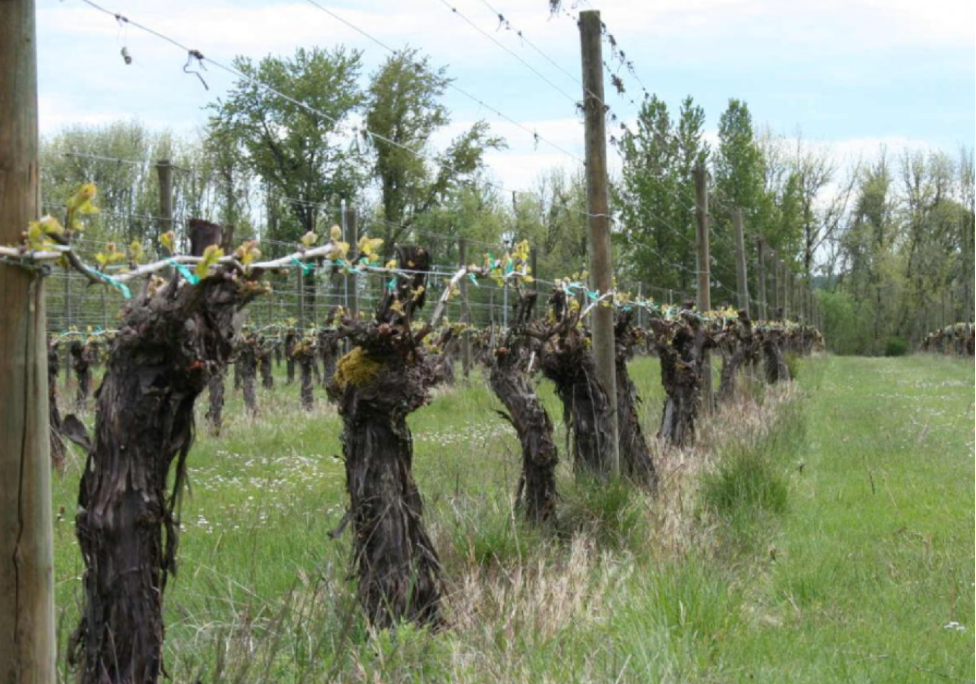
In 2006, the Buchanans' daughter, Merrilee Buchanan Benson (pictured below, credit Wine Trail Traveler), who grew up on the Buchanan Century Farm, became the head winemaker and vineyard manager coinciding with Tyee’s production of only estate wines made from grapes grown exclusively on the family’s Estate Vineyard adjacent to the winery. Merrilee has consistently produced outstanding Pinot Noir wines. Merrilee says, “Good wines remember the grapes of their origin.” I have reviewed nearly every vintage of Tyee Wine Cellars Pinot Noir between 2006 and 2007: www.princeofpinot.com/winery/997/.
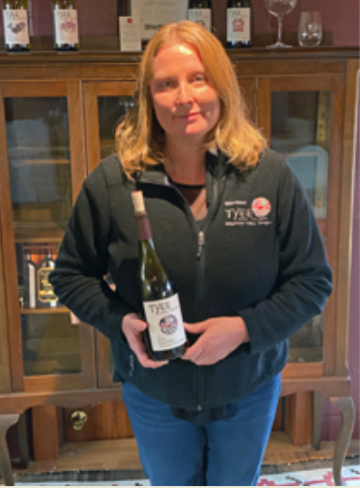 There are two featured Pinot Noir wines: the Tyee Estate Willamette Valley Pinot Noir ($24) and the limited release Tyee Estate Barrel Select Willamette Valley Pinot Noir ($35). The Estate Pinot Noir is composed of newer and old vine Pommard clones and Dijon clones. The Estate Barrel Select Pinot Noir is 100% Pommard clone made from a combination of own-rooted Pinot Noir vines that are 25 to 47 years old, and newer plantings that include Merrilee’s favorite barrels of the vintage. It typically benefits from cellaring. The wines of this heritage and quality are rarely so affordable. Also check out the winery’s old vine Chardonnay, Gewürztraminer, and Pinot Gris. The winery’s tasting room is located in the historic former milking parlor used by third-generation Buchanans who raised Jersey cows on the Century Farm. Tasting is available from 12:00 pm to 5:00 pm April through December ($10). Current production is between 1,500 and 2000 cases annually. The photo below shows the Tyee Estate Vineyard solar panels that power the winery and the red-roofed tasting room and winery.
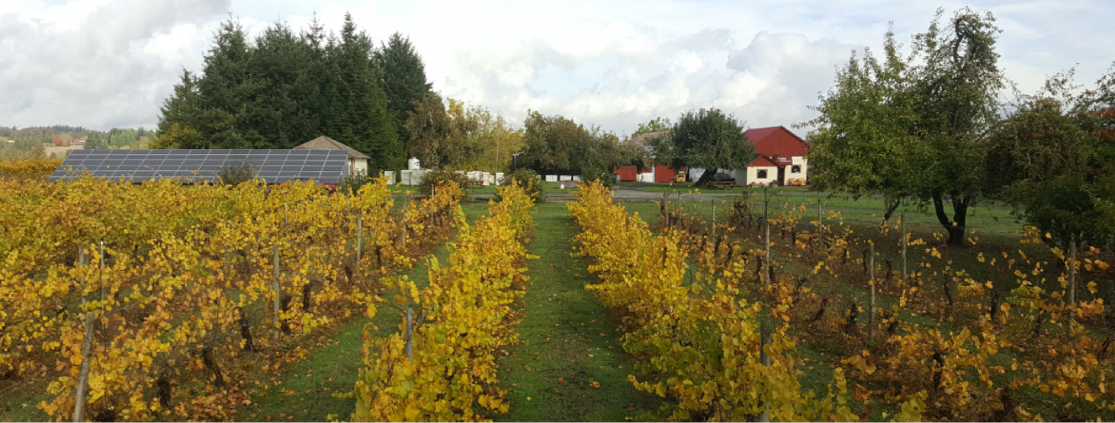
2017 Tyee Estate Willamette Valley Pinot Noir 13.5% alc., 800 cases, $24. 100% Pommard, 777, and 115 clones from the Tyee Estate Vineyard. Whole berry and whole cluster fermented. Aged 18 months in French oak barrels, 15% new. Bottled unfined and unfiltered. · Moderate garnet color in the glass. Enticing aromas of black cherry, cola, and a floral lift.The bold flavors of black cherry, ripe strawberry, spice, cola and black tea are sturdy on the palate, making quite an impression. Instantly enjoyable, with easygoing tannins and a seamless, very long finish. Tasted twice 6 months apart and even better after more aging. The 2018 vintage is now being offered. Score: 93
2017 Tyee Estate Barrel Select Willamette Valley Pinot Noir 13.5% alc., 800 cases, $35. 100% Pommard clone from the Tyee Estate Vineyard. Whole berry and whole cluster fermented. Aged 18 months in French oak barrels, 25% new. Bottled unfined and unfiltered. · Moderate garnet color in the glass. Pleasing aromas arrive over time in the glass including blackest cherry, blackberry, burnt tobacco and potpourri. Striking mid-weight plus flavors of black cherry and blackberry framed by sturdy but well-proportioned tannins that contribute to the excellent harmony. An unbelievably long finish is lush with sweet Pinot extract. Even more terrific when tasted the following day from a previously opened bottle. Drinkable now, but cellaring will bring more rewards. Tasted twice with consistent results. Score: 95
Looking Back: Josh Jensen Spouts OffThe last issue of the PinotFile reported the recent passing of Josh Jensen, a California Pinot Noir legend. He came to winemaking after pursuing an education at Yale and Oxford and working harvests in Burgundy at both DRC and Domaine Dujac. He searched for limestone soils similar to those found in Burgundy and ended up in the Gabilan Mountains near Hollister in 1974. Jensen was the winemaker starting in 1978 for the early vintages of Pinot Noir from his Jensen, Reed, Selleck and Mills vineyards. Steve Doerner took over until leaving for Oregon and helping to establish Cristom Vineyards. in the early 1990s.
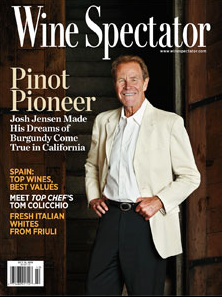 Jensen was widely admired for his unwavering commitment to producing wines that best reflected his terroir without any condescending nod to the expectations of the commercial wine press. It was not surprising, then, that he posted an inflammatory commentary that accompanied his 2004 Calera fall wine offering. In this, the 30th harvest for Calera, Jensen spoke out about the winemaking trends that dominate today’s wines. Although this was 18 years ago, there still are truisms that hold today. It is highly unusual for a winemaker to call out his perceived shortcoming of other’s winemaking styles, but Jensen always defended his philosophy of growing and producing classic Burgundian-style wines from his unique vineyards. Some wine critics have considered Calera Pinot Noirs closest to the Burgundian idiom of all Pinot Noirs in California. The wines are shy upon release, with the best drinking window between 5 and 20 years after the vintage. Fortunately, Calera has always offered library wines so as to experience them at their best. Jensen’s vision for the perfect Pinot Noir is one “that is perfectly balanced on the cusp of richness and complexity, of fruitiness and subtlety, and is neither one nor the other.” Jensen posted the following under the title, ‘Blasters of the Universe, A Cautionary Tale.’ “The trend that has occurred over the last 20 years is toward a style I will call Blaster-Smasher Pinots: exceptionally dark, cloying, overblown, sledgehammer wines that are unlike anything you could find in a wine shop 30 years ago. These present-day behemoths, which to me are cartoonish freaks, the Pamela Lee Andersons of the wine world, draw raves from all of the U.S. wine publications nowadays, and are avidly sought out by collectors, and therefore, by the wine trade. These Smasher-Blasters, often called Fruit Bombs, are mostly one-dimensional, simple but potent beverages that will merely lose their fruit, their main if not their only appeal with the passing years and just turn into…mud. Expensive mud. And dull, to boot. Many of the wineries making this style of wine are quite new to the game. I think of these new breeds of eager winemakers as the Blasters of the Universe, making their ultra-dark, mouth-exploding Pinots that burst through the old boundaries and seem to be trying to flex their muscles.” Jensen goes on to say, “These ultra-dark, fruit bombs are the result of 3 factors: (1) new Pinot Noir clones which ripen earlier and give fruitier wines, (2) cold soak prior to fermentation increasing wine-skin contact time and extracting more color, and (3) blending in other grape varieties, particularly Syrah which makes the wine darker.” The latter of course is blasphemy in Burgundy but Jensen is implying that this occurs in the U.S. A year prior to Jensen’s remarks, Robert Parker, Jr. tasted through 64 single-vineyard Calera Pinot Noirs dating back to 1987 that was published in November 2003 at eRobertParker.com. Although Parker is known for his stylistic preferences that lean toward fruit bombs, his general impression was that there were enough great wines to convince him that Calera was “one of the most compelling Pinot Noir specialists of not only the New World but of Planet Earth. The current vintage release of Calera’s single-vineyard Pinot Noirs is 2019, but 2017 and 2018 vintage wines are also available on the winery’s website at www.calerawine.com. KLWines, a superb retailer source of domestic Pinot Noir, is now offering Calera’s Historic Library Collection at www.klwines.com. Vintages dating back to 1984 including some magnums and even 3L bottles! I wonder if this offering is from Jensen’s personal cellar? Jensen’s philosophy and preferred style are so ingrained at Calera, that despite Jensen’s passing and new ownership (Duckhorn Wine Company), the wines will continue to be true to his vision. The last Calera Pinot Noir I reviewed was in late 2021:
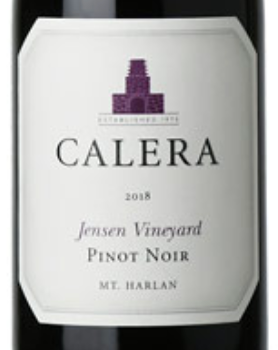 2018 Calera Jensen Vineyard Mt. Harlan Pinot Noir 14.7% alc., $100. Whole cluster and native yeast fermented. Aged in French oak barrels, 30% new. · Moderately dark garnet color in the glass. The nose rises up over time revealing wonderful aromas of dark berries, plum, dried beef, clay, and wine cellar. Inviting flavors of purple grape and pomegranate framed by supportive and fine-grain tannins and a good cut of acidity. The finish is drenched in ripe dark fruits and is amazingly long. The fruit is definitely ripe but not over-mature. The wine was even better when tasted the following day from a previously opened bottle when some alluring spice shows up and the long finish continues to amaze. Very age-worthy. Score: 95
Newsworthy BriefsInternational Pinot Noir Celebration Announces 2023 Theme & Speakers Held annually as usual at Linfield University in McMinnville, Oregon, the 2023 Grand Seminar will be Planet Pinot - Vintage 2050 - Visions for the Future. The 2023 Master of Ceremonies will be duo Dorothy J. Gaiter and John Brecher, wife and husband American journalists and wine critics. The 3-day weekend will feature over 70 International Pinot Noir producers and over 50 noted and award-winning chefs from the Pacific Northwest. Register for the Full Weekend at www.ipnc.org ($1,495 not including accommodations).
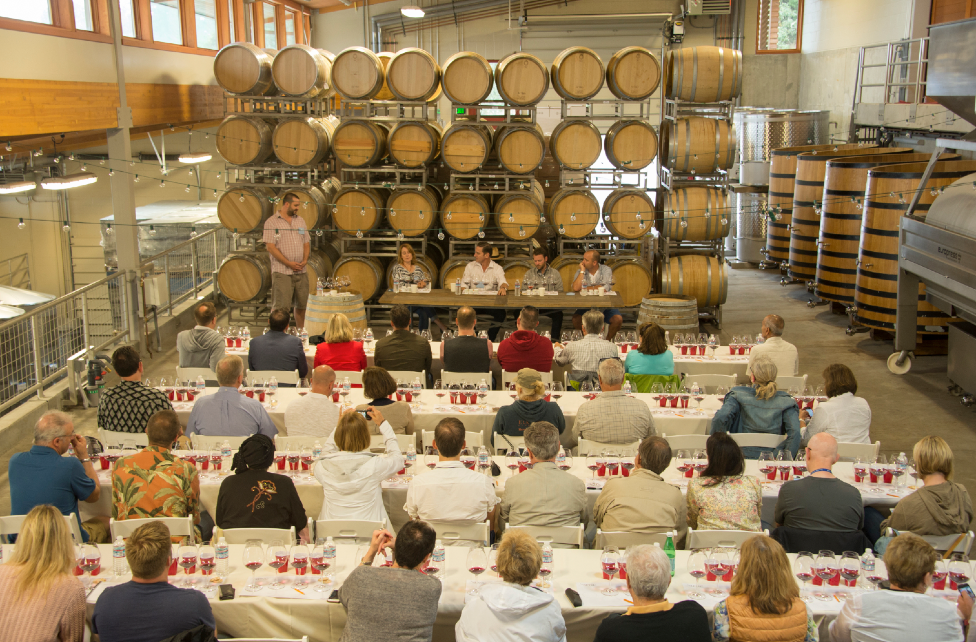 AXA-Millesimes Buys Platt Vineyard Platt Vineyard, consisting of 38.8 acres of Pinot Noir and Chardonnay located between Freestone and Bodega was planted by the late Lew Platt, a former CEO of Hewlett Packard and Boeing and executive oat Jackson Family Wines. A number of top North Coast wineries have sourced fruit from Platt Vineyard, including Cattleya, Littorai, Ramey, Rivers-Marie, Radio-Coteau, Red Car, Scherrer and Tongue Dancer. AXA Millesimes owns the vineyards of Outpost Winery on Howell Mountain, Domaine de l’Arlot in Burgundy, Chareau Pichon Baron in Paulliac and a range of other properties worldwide. Platt Vineyard is considered by many cognoscenti as one of California’s greatest Pinot Noir and Chardonnay vineyards. Pete Soergel Appointed Director of Winemaking and Vineyards at Lynmar Estate Pete has been the winemaker at Lynmar for the past five years and will now oversee Lynmar’s vineyard team and the farming of its four vineyards, Quail Hill Vineyard, Adam’s Vineyard, Susanna’s Vineyard, and Hessel Station Vineyard (85 acres total). Hopefully, you can meet Pete on one of your visits to Lynmar Estate as he is a fine and very wine-knowledgeable person. Elderly Cognition Benefits from Wine A Japanese study published in BMC Geriatrics looked at lifestyle data from Japanese seniors over age 75 and found moderate and consistent wine consumption was associated with better cognitive function. A significant association with wine was not found for other types of alcoholic beverages. The study's author suggests that antioxidants such as polyphenols found in wine, particularly red wine, may be responsible for a favorable effect on cognition. One caveat is that the older people in the study participated voluntarily and could be healthier than the average member of the aging population studied. The researchers hope to study the effects of red wine versus white wine. Pinot Noir the Healthiest Red Wine? Most scientific research on the health benefits of wine has focused on the antioxidant polyphenols found in the skin and seeds of grapes that include resveratrol, quercetin, anthocyanins, procyanidins, ellagic acid, and catechins. Cornell scientist Leroy Creasy first isolated resveratrol from red wines in 1991 and later theorized that resveratrol was at least partly responsible for red wine’s apparent health benefits. A plethora of research studies followed. The levels of resveratrol vary among different grape varieties and vineyard locations but average about 200 mg in one glass of red wine versus 40 mg in one glass of white wine.Red wines that are dark in color and high in tannins have higher polyphenol content such as Tannat, Petite Sirah, Nebbiolo, and Cabernet Sauvignon. However, although Pinot Noir is a thin-skinned grape, it has among the highest levels of resveratrol of all red grapes because it is grown in cooler climates. The highest levels of resveratrol are found in wines from cooler climates since resveratrol fade in strong sun. Techniques of maceration play a large role as well.
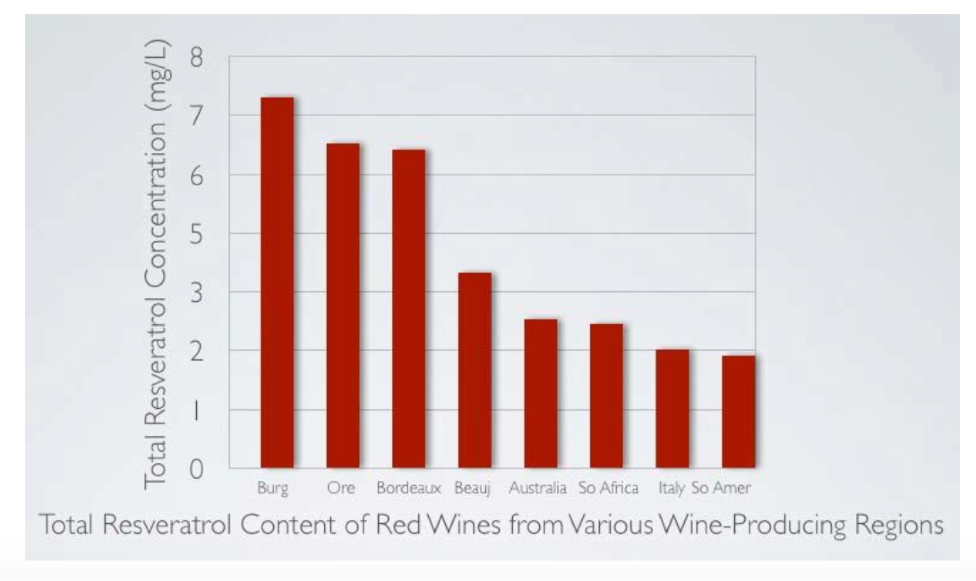 Corollary Wines to Develop Oregon Vineyard Exclusively Dedicated to Sparkling Wines Corollary Wines purchased 57 acres in Oregon’s Eola-Amity Hills and is planning on planting a 15-20 acre estate vineyard and build a winery and tasting room specifically for sparkling wines. This is a first for Oregon. The vineyard will be managed and developed under the guidance of permaculture and regenerative agriculture practices. The land was previously used for timber and has never before been planted as a vineyard. Owners of Corollary Wines, Dan Diephouse and Jeanne Feldkamp, have been crafting traditional method sparkling wines in Oregon’s Willamette Valley since 2017. Follow the development of the property at www.corollarywines.com. The Latest News from West Sonoma Coast Vintners (WSCV) Sign up on the WSCV website at www.westsonomacoast.com for the organization’s periodic email newsletter detailing events and member winery information and wine reviews. WSCV members whose wines have been reviewed in the PinotFile include Alma Fria, Balleto, Banshee, Black Kite Cellars, DuMOL, Ernest Vineyards, Failla Wines, Flowers Vineyards & Winery, Freeman Vineyard & Winery, Gros Ventre Cellars, Hirsch Vineyards, Joseph Phelps Vineyards, Littorai Wines, Marine Layer, Matt Taylor Wines, Occidental, Peay Vineyards, RAEN, Red Car Wine, Small Vines Wines, Senses Wines, and Wayfarer. Bad News for Wine Sales The 2022 Silicon Valley Bank State of the Wine Industry Report (www.svb.com) notes that there is a real challenge in recruiting younger consumers into the wine category combined with the aging of the older boomer core of wine consumers. “These consumer groups have different values and spending patterns and the wine industry has done little to alter their marketing message to attract or retain either consumer cohort.” There exists an over-dependence on the retiring boomer. In a Harris Poll that asked, “What would you bring to share at a party?” almost half of the boomers (65+) preferred wine, while only 15% of those ages 21-34 would choose beer and spirits over wine.
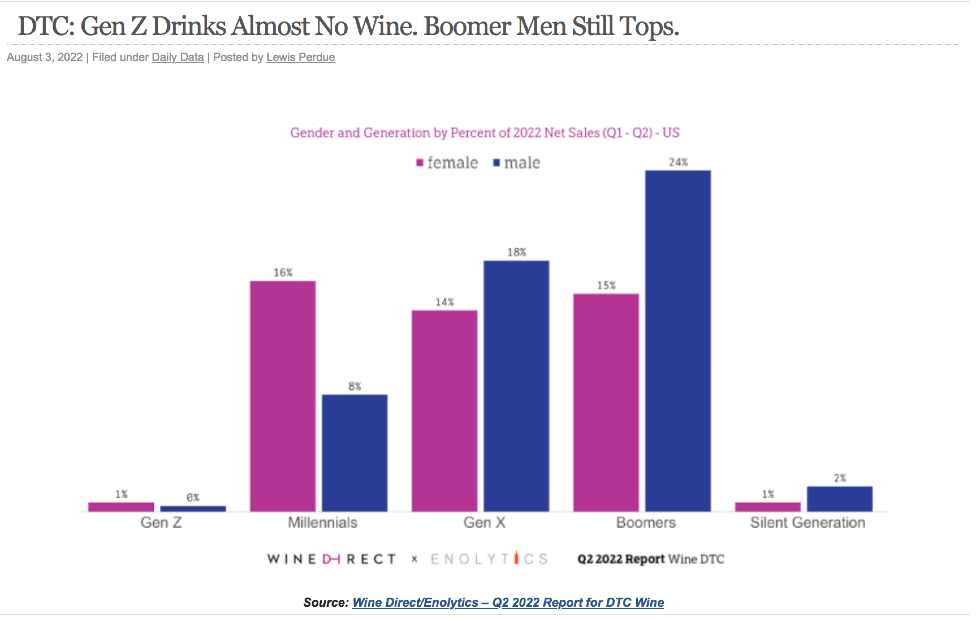 Another 100-point Pinot Noir Surfaces As the escalation of scores for domestic Pinot Noir shows no sign of subsiding, a new 100-point “perfect” score has been awarded to the 2019 Occidental SWK Vineyard Sonoma Coast Pinot Noir by Erin Brooks, a reviewer for Robert Parker’s Wine Advocate. Brooks also gave extremely high scores to other 2019 Occidental Sonoma Coast Pinot Noirs including Running Fence Cuvée Catherine (99 points) Bodega Ridge Vineyard (98 points), Occidental Station Vineyard (98 points), and Bodega Headlands Vineyard (97 points). Occidental, was co-founded by Steve Kistler, the former winemaker for well-known Kistler Vineyards. Kistler gravitated to this rural West Sonoma Coast outpost after making Pinot Noir from two nearby vineyards, Hirsch and Camp Meeting Ridge. In 1999, he bought 20 acres in Occidental and subsequently acquired more parcels to bring the total to 85 acres among four Pinot Noir vineyards. The vineyards were planted in the early 2000s with a Calera selection and field selections from Vosne Romanée that Kistler acquired in the early 1990s and propagated. Kistler built a winery east of the town of Bodega on a ridge next to the Bodega Headlands Vineyard. The winery is independent of Kistler Vineyards. A tasting room with tastings by appointment is open on the winery property. Visit www.occidentalwines.com. How do I feel about 100-point scores? Visit www.princeofpinot.com/article/2378. Flooded With Fall Release Pinot Noir Offerings Why do so many wineries offer their fall 2020 releases in July and early August seemingly all at once? I have seen fall release offerings in the last month from Williams, CIRQ, Cobb, DuMOL, Dutton-Goldfield, Ferren, J. Rochioli, Kutch, Littorai, Paul Lato, Rivers- Marie, and Williams Selyem. Many of the offered Pinot Noir wines are in the $80-$100+ range so unless you are filthy rich, there is no way you could buy your allocations. I guess all these wineries have their devotees so the winery easily sells most or all of their releases regardless of when the wines are offered. Open your Italian leather wallet and say, “Pinot!” As a side note, it should be mentioned that the LNU Complex fires ripped through Sonoma County in August and September and the Glass fire ignited in late September. Smoke lingered over vineyards for 3 months yet many of the above-mentioned producers released many of their 2020 Sonoma County Pinot Noirs because they were fortunate to harvest grapes before the effects of smoke could endanger the grapes.
Wine in Moderation Can Be Part of a Healthy LifestyleI recently wrote this piece for a cardiologist for him to use to inform his patients. Readers may find it of interest. Many years of scientific research support the notion that wine if consumed in moderation regularly with food and combined with a healthy lifestyle that includes (1) avoidance of smoking, (2) staying lean, (3) exercising regularly at least 30 minutes five times a week, and (4) following a diet low in animal fat and high in fiber, whole grains, fruits, and vegetables, can offer significant health benefits. The following are considered by the medical community to be generally accepted truths:
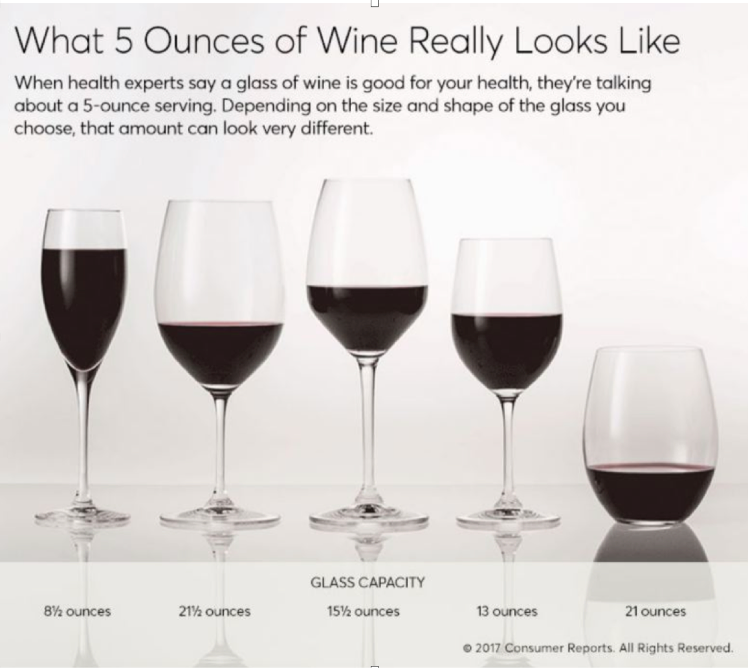
The importance of moderation in wine and alcohol consumption, in general, cannot be overemphasized. Good wine challenges our human frailties because if it tastes good, we want to drink more of it, but there is no added benefit to drinking more than moderate amounts of wine daily. The term, hormesis, applies here, meaning a biological phenomenon in which the favorable effect of a moderate dosage of a substance is toxic in higher doses. Heavy drinking should be avoided as it can lead to a number of serious health problems including high blood pressure, heart attack, cardiac arrhythmia, stroke, decreased longevity, type 2 diabetes, alcoholic hepatitis, tremors, dementia, and cancers of the back of the throat and gastrointestinal tract. One is much better off not to drink at all than to drink too much wine. However you view the health claims for wine, it is hard to argue against a diet rich in fruits, vegetables, and a modicum of red wine. Even the great sage, Johnny Carson, knew the benefits of wine. After undergoing quadruple bypass surgery, he offered the following advice to David Letterman who was recovering from quintuple bypass surgery, “Drink more red wine.” Your physician should always be consulted about the effects of wine consumption on your health as well as lifestyle and diet advice, and you should choose a personalized course. Be perfectly honest about your drinking habits. Medical professionals do not advise abstainers to begin drinking for health reasons.
Husch Vineyards: Dependable Everyday Anderson Valley Pinot Noir
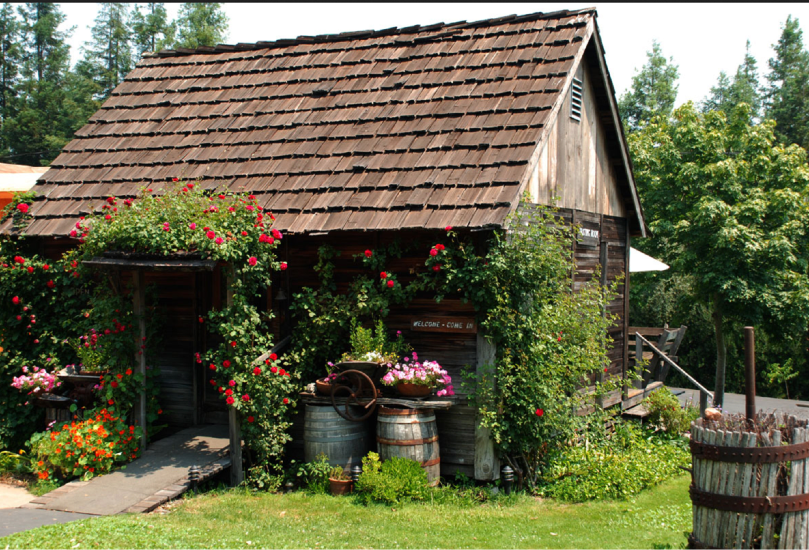 Husch Vineyards is the oldest winery in the Anderson Valley, dating to 1971. In 1968, Tony and Gretchen Husch bought the 60-acre Nunn Ranch located between Philo and Navarro on Highway 128. They soon planted Chardonnay and Gewûrztraminer, added Pinot Noir in 1971, and then added Sauvignon Blanc and Chenin Blanc in 1980. The first crush came in 1971 and the first Pinot Noir in 1973. In 1979, Hugo Oswald Jr. bought the Husch Vineyards winery from the Husch family. Today, Husch Vineyards is owned and operated by the third generation of the Oswald family including siblings Zac Robinson and Amanda Robinson Holstine. Brad Holstine has handled the winemaking since 2006. Through the years, Husch Vineyards has expanded and modernized, but it has never lost its rustic charm or reputation for producing great wines. I consider Husch Vineyards Anderson Valley Pinot Noir one of the few under $30 domestic Pinot Noirs worth drinking and my opinion has been unwavering over many years of tasting this wine. The 2019 vintage reviewed here is no exception. The 2020 vintage has also been released. The large production of this wine provides widespread availability in the retail marketplace as well as at the winery at www.huschvineyards.com. The Husch Tasting Room pictured above was originally a pony barn dating back to the early 1900s and has been open to the public since Husch’s inaugural 1971 vintage.
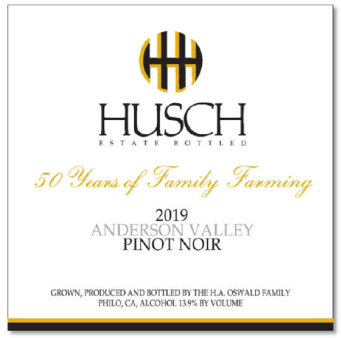 2019 Husch Vineyards Anderson Valley Pinot Noir 13.9% alc., pH 3.60, TA 0.53, 4,717 cases, $25. A blend of grapes from throughout the Anderson Valley from the warmer Boonville area all the way through to the norther cooler “deep end” vineyards. Harvest Brix 23.3º-26.1º. 10% whole cluster. Aged 9 months in French oak barrels, 23% new. · Moderately light garnet color in the glass. The aromas and flavors of candied darker cherry, raspberry, ripe strawberry, red licorice, and spice are quite agreeable upon opening and acquire intensity over time in the glass. Light-to-mid-weight in style, with gracious tannins, uplifting acidity, and a quenching finish. A chivalrous wine that will be equally enjoyable on its own or at the dinner table. Score: 91
|